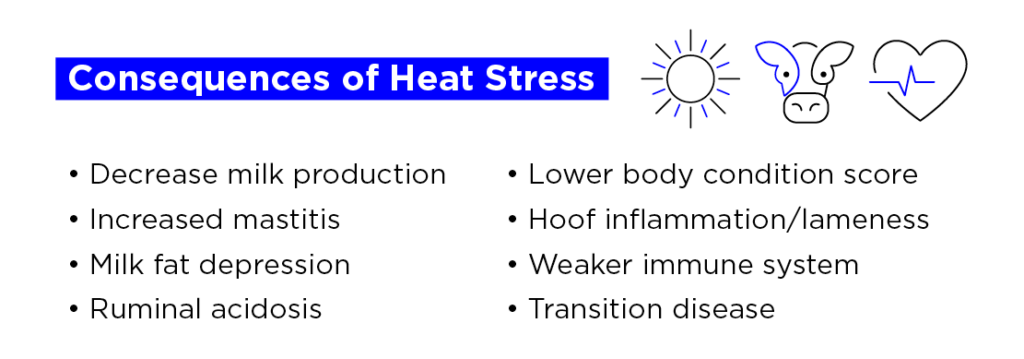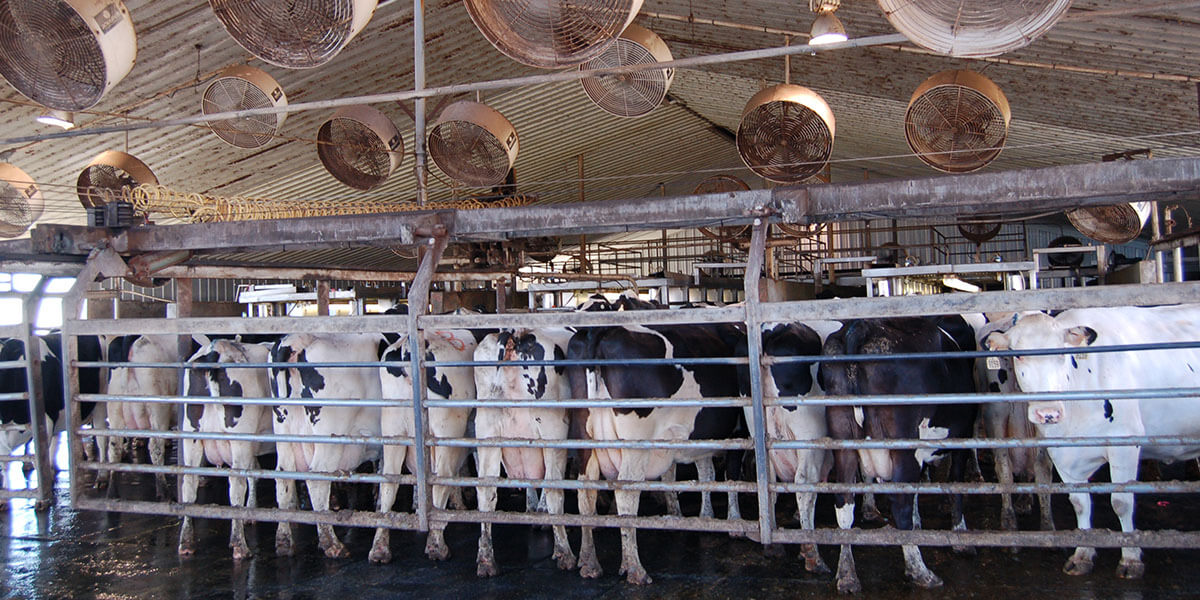Heat stress is one of the many factors that can contribute to lameness in cows. It is common to see an increase in the number of claw lesions in cows at the end of the summer, most often driven by a change in the cows’ behavior or their diet, but also by the increased risk of sub-acute ruminal acidosis (SARA) or other digestive disorders that can result in decreased milk production efficiency, impaired cow health and higher rates of early culling.
Dairy cows begin to show signs of heat stress when the temperature humidity index nears 68 degrees Fahrenheit (20 degrees Celsius), which is well below the point where humans begin to perceive heat stress. They may begin to show an elevated respiratory rate and body temperature, decreased feed intake and reduced production and reproduction performance. In severe cases of heat stress, cows will begin open-mouth breathing, also known as thermal panting. Keeping cows as comfortable as possible when they are suffering from heat stress can minimize the loss of milk and reproduction performance, minimize the increase in standing times and associated increase in new claw lesions, and maintain calf birth weights.

Here are five heat stress management steps you can implement in your dairy operation:
1. Ensure Cows Have Adequate Access to Water
Ensuring that cows have easy access to water is the top priority in mitigating heat stress. When cows are suffering from heat stress water, intake increases by 20 to 200 percent.
To optimize cows’ water consumption, you should provide direct access to clean water as cows enter and exit the milking parlor, when they are in the holding area and within 50 feet (15 meters) of the feed bunk. There should be at least two functioning waters available per pen.
Below are some additional ways to optimize cows’ water consumption:
- Ensure adequate flow rate to maintain a minimum water depth of 3 inches (7.6 centimeters) in the trough.
- Provide available trough space of 3.5 linear inches (9 linear centimeters) per cow.
- Monitor stray voltage in water troughs and in the areas around them.
- Ensure flow rates are adequate to meet peak demand.
- Keep waterers clean.
- Check milk quality characteristics at least 1 or 2 times a year.
2. Install Soakers in Holding Area, Feed Bunk and Pens
Keeping cows properly cooled in the holding areas can help them be more productive as well as prevent heat stress. Research shows that cows that are properly cooled can produce an additional 1.7 to 5 pounds (0.8 to 2.3 kg) of milk per day.
It’s important that the water droplets are large enough to soak into the cow’s hide as droplets that are too small merely create an insulating layer on the surface of the hair, leading them to become even hotter.
Soakers should be set to activate at 70 degrees Fahrenheit (21 degrees Celsius). Soaking frequency should be increased as the temperature increases. In humid environments, the thermostat should be set to begin soaking sooner and more frequently.
The system should be sized to provide 0.34 gallons (1.3 liters) of water per cow, per soaker cycle. Sprinklers should wet the back and then stop to allow the water to evaporate prior to another cycle beginning.
3. Provide Recirculation Fans and Adequate Ventilation
Installing fans improves air movement but does not improve ventilation. Fans should be positioned in the holding area, over the stalls and over the feed bunk, but it is not uncommon to see fans used over the stalls and not over the feed bunk in many free stall pens.
Fans should be run continuously at 65 degrees Fahrenheit (18 degrees Celsius) to provide 5-8 mph (8-13 kph) airspeed over the cow stalls and feed alley, aligned to flow in the direction of prevailing winds. Appropriately space the fans and angle the air flow down toward the cow.
The use of soakers and fans is most effective. If you cannot use both, you should use low-pressure sprinklers, which cool more efficiently than fans alone.
4. Provide Adequate Shade
Cows housed in dry-lot pasture situations should be given shade, which may be natural — such as a tree line — or man-made using steel or aluminum. Provide 40-45 ft2 (3.7-4.2 m2) of shade per cow with a north-south orientation to prevent wet areas from developing underneath.
5. Prevent “Bunching” of Cows
When cows are suffering from heat stress, they instinctively look for a dark place to escape the heat. This causes the animals to bunch together, creating additional stress.
To avoid bunching, close curtains on the bright side of the barn by 80 percent or invest in shade blinds that can be pulled down over the sidewall. Avoid using transparent siding on the ends of the barn as this lets in more light during the summer and increases the variability in light intensity through the pen. Controlling flies in the pen is also important to avoid bunching.
To learn more about decreasing heat stress on a dairy operation, contact a Zinpro representative today.

